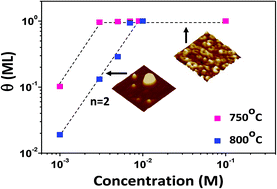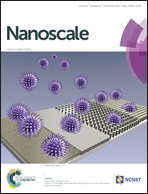Nucleation kinetics of SrTiO3 3D islands and nanorings on Si substrates
Abstract
The nucleation of SrTiO3 three-dimensional (3D) islands and nanorings on Si substrates via a novel metalorganic decomposition (MOD) process has been investigated as a function of temperature and solution concentration of the SrTi(OC3H7)6 precursor. Quantitative analysis of island density and size distribution by atomic force microscopy (AFM) has revealed the existence of a nucleation regime at solution concentrations below 5 × 10−3 M, in which the critical nucleus is a trimer and a coalescence regime at higher concentrations, dominated by growth of immobile clusters. Nanorings form preferentially under high supersaturation conditions and their size distribution is consistent with a dynamic coalescence. On the basis of recent theoretical models (Gill, 2012), we have proposed that the island-to-nanoring transition in the SrTiO3/Si system occurs above a critical size as a result of a competition between energetic and kinetic factors. The combination of high-resolution transmission electron microscopy (HRTEM) and attenuated total reflectance Fourier transform infrared spectroscopy (ATR-FTIR) has shown that the monocrystalline SrTiO3 nanoclusters grow pseudomorphically on the Si substrate and exhibit a strain-induced tetragonal lattice distortion.


 Please wait while we load your content...
Please wait while we load your content...